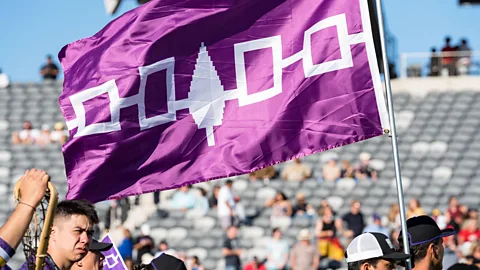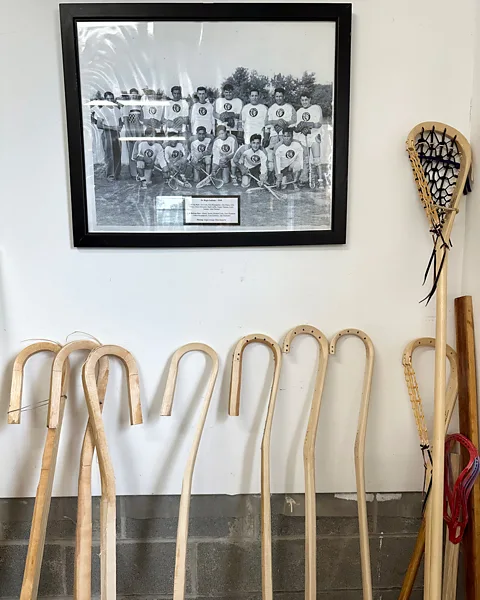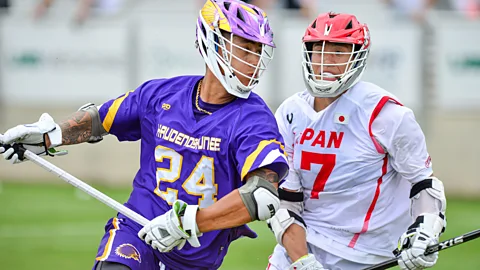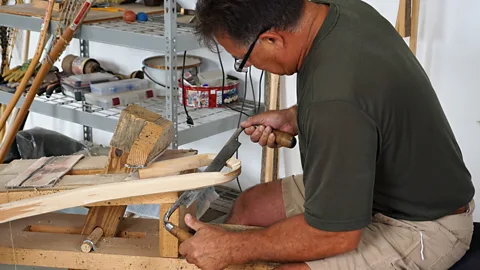The Indigenous roots of a revived Olympic sport
 Alamy
AlamyOne of the fastest growing sports in North America, lacrosse is headed back to the Olympics. But the game's creators may not be invited.
When First Nations Haudenosaunee people say that someone was born with a lacrosse stick in their hand, it's not far from the truth. "We have these little cradle sticks," says Lewis Mitchell, a lacrosse stick-maker and lifelong player. "Parents who want their children to play lacrosse, they take that stick and they put it into the cradle with the baby."
Mitchell's workshop is in Snye, Quebec, a pene-exclave of Canada south of the St Lawrence River. Snye, or Tsi Snaihne in Kanienʼkéha, the Mohawk language, is part of the Mohawk territory of Akwesasne, which straddles the US-Canada border and has portions in New York, Ontario and Québec. Lacrosse has deep roots here. The game is said to have been invented around 1,000 years ago by the Haudenosaunee – the confederacy made up of the Mohawk, Onondaga, Oneida, Cayuga, Seneca and Tuscarora nations of north-eastern North America – and Akwesasne once produced most of the world's wooden lacrosse sticks.
Since the advent of plastic sticks in the 1970s, wooden sticks are today largely made for nostalgic, decorative or ceremonial purposes, but Mitchell and his fellow lacrosse stick-maker Evan Cree help ensure that the craft is not lost. Workshop visits with both men are part of Akwesasne's emerging tourism industry, which weaves lacrosse into its tours as a lens into its culture, history and artistry. Whether viewing exhibits on the evolution of lacrosse at the Akwesane Cultural Center or learning about log pounding while watching basket maker Carrie Hill at work, the topic of lacrosse is a frequent one in Akwesasne.
And this combination of cultural tourism and sport hits a sweet spot: not only is Indigenous tourism rapidly growing, so too is lacrosse. It's one of the fastest growing sports in North America and recently received another boost: in 2028 lacrosse will be competed at the Olympic Games in Los Angeles for the first time in more than a century – in the compact sixes format.
 Karen Gardiner
Karen GardinerAs Mitchell leads me through the steps of turning a hickory log into a lacrosse stick – bending the top of the stick around a jig to form the head, then carving it with a drawknife on a shaving horse (a combined vice and workbench) – he fills me in on his years of playing lacrosse with Akwesasne teams and competing internationally as a member of the Iroquois (now Haudenosaunee) Nationals. Mitchell was inducted into the Akwesasne Hall of Fame in 2015 and the Ontario Lacrosse Hall of Fame in 2019 but he's humble about his own achievements. It's when he starts talking about the lacrosse "legends" he played against during his heyday that I sense he could keep talking all day. He reminisces about the "great rivalries" with other Mohawk communities such as Kahnawáke, near Montreal, and remembers the "honour" of playing against Sid Hill, now Tadodaho, or traditional leader, of the Onondaga Nation.
The passion with which Mitchell speaks about lacrosse is typical of many Haudenosaunee, to whom it's more than just a game. Many believe that lacrosse was a gift from the Creator for enjoyment and healing, and it appears in Haudenosaunee creation stories. The wooden stick, traditionally made from natural materials (wood and sinew) has its own spiritual significance. To this day lacrosse is played as both competition and ceremony – during times of difficulty, "medicine games" are called to lift the spirits of communities in need, Mitchell explains.
Medal Moments
Want to read more about the Olympics? Sign up for Medal Moments, your free global guide to Paris 2024, delivered daily to your inbox throughout the Games.
It's because of this deep reverence for lacrosse that the recent Olympic announcement has been met with both excitement and concern. It's unclear if the Haudenosaunee, the game's creators, will play lacrosse at LA 2028.
The Haudenosaunee Nationals was founded by a group of players including Oren Lyons (Onondaga) and Richard Hill and Wes Patterson (both Tuscarora) in 1983 as the Iroquois Nationals – in 2022 the team changed its name from the once-prevalent but derogatory Iroquois. The men's team was officially recognised by World Lacrosse (then the Federation of International Lacrosse) in 1988, and the women's in 2008.
 Alamy
AlamyDespite drawing from a far smaller pool than other nations, the men's and women's teams are among the world's best – currently third in the men's field rankings and eighth in the women's. But because the Haudenosaunee do not have a National Olympic Committee – or a government recognised by the United Nations – they're not recognised by the International Olympic Committee (IOC). So Haudenosaunee players are left with the choice of playing for the US or Canada, or not at all.
But they do have support. Notably from President Biden who said: "Their ancestors invented the game. They perfected it for a millennium… they should be granted an exception to field their own team at the Olympics." And there is precedent for the IOC to make an exception: the Refugee Olympic Team was created in 2015 to, as the IOC states, send "a message of hope and inclusion… and inspir[e] the world with the strength of their human spirit".
The Haudenosaunee road to LA 2028 may not be straightforward but, as Rex Lyons, former Nationals player and current board member (and Oren's son), reminds me, "all these hoops and hurdles are not of our own making."
Not being recognised, Lyons says, "is beyond our control. We travel on our own [Haudenosaunee] passports. We're sovereign… we're still operating on original treaties [and] we were sovereign long before our European brothers stumbled onto our shores."
 Karen Gardiner
Karen GardinerAbenaki scholar Christine O'Bonsawin writes that the IOC "forces Indigenous athletes to assume the identity of the colonizing settler citizenry." In 1904, a lacrosse team made up entirely of Mohawk players competed at the Olympics, but under Canada's flag. An Indigenous team has not yet competed under its own flag. Individual players who hold dual passports could qualify for the US or Canada squads, but that's not really the point. To many Haudenosaunee, competing as a nation means as much as competing at the Olympics.
Having played for the Nationals and followed its evolution, Mitchell has seen first-hand how having a national team has affirmed Haudenosaunee identity and place in the world. He recalls travelling to Australia to play with the team and seeing the Haudenosaunee flag raised on an equal level alongside those of other countries. "That was just something I had never seen in my life: to have our flag up there with these other nations. It was just amazing."
Mitchell believes that the existence of a national team has been transformative. "I look around our communities today and see more and more pride in the Haudenosaunee flag," he says of the flag that was designed for the national team and has since been adopted as a Haudenosaunee symbol. "I think it's helped to bring us all together and give us a sense of who we really are."
 Karen Gardiner
Karen GardinerAfter visiting his workshop and seeing how a traditional lacrosse stick is made, Mitchell recommends visitors catch a game at A'nowara'kó:wa Arena where, in summer, Akwesasne Thunder takes on teams from the Ontario Junior B Lacrosse League – indoor, or box, lacrosse is a particularly fast-moving form of the sport, which lives up to its Mohawk name, teiontsikwaeks ("they bump hips"). In September the Haudenosaunee Nationals will contest the 2024 World Lacrosse Box Championships in Utica, New York, three hours south of Akwesasne.
For now, Lyons says the Nationals are focused on putting their "ducks in a row, so that when we actually submit for Olympic inclusion, we have a very strong position." Although the IOC has issued discouraging statements over recent months, Lyons remains optimistic, saying that once they "get some information about who we are," the IOC will understand that Haudenosaunee participation at LA 2028 would be "a win-win for everybody."
"The IOC can really hang their hat on this, because they're using such language as 'diversity, inclusion'… we check a lot of boxes."
 Alamy
AlamyLyons also points out that a Haudenosaunee mantra is "peace, friendship and healing through sport". That sounds a little like the Olympic movement's ideals.
"We don't have to choreograph any of this. This is who we are," says Lyons. "Can you imagine the opening ceremony of the Olympics?" he asks, then paints a picture of the team entering the stadium in full regalia: "Very colourful – we're dancing and we uplift the spirit. Because that's what lacrosse is [for]: to lift the human spirit."
--
If you liked this story, sign up for The Essential List newsletter – a handpicked selection of features, videos and can't-miss news, delivered to your inbox twice a week.
